The Birds of Your Backyard
Live in harmony with your backyard. Birds
Birds
South Carolina is home to a number of different bird species.
Here are some of the birds you are most likely to see in your yard.
American Goldfinch

Photo: Zach Steinhauser
Habitat
Patches of thistles and weeds, roadsides, open woods, edges. Found at all seasons in semi-open areas having open weedy ground and some trees and bushes for shelter, especially areas of second growth, streamsides, roadsides, woodland edges, orchards, suburban areas. In winter also in some very open fields farther from trees.
Feeding Behavior
Forages actively in weeds, shrubs, and trees, often climbing about acrobatically on plants such as thistles to reach the seeds. Except during breeding season, usually, forages in flocks. Commonly comes to feeders for small seeds.
For more information visit: https://www.audubon.org/field-guide/bird/american-goldfinch
American Robin
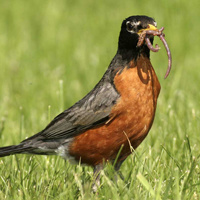
Claude Nadeau/VIREO
Habitat
Cities, towns, lawns, farmland, forests; in winter, berry-bearing trees. Over most of the continent, summers wherever there are trees for nest sites and mud for nest material. In arid southwest, summers mainly in coniferous forest in mountains, rarely in well-watered lowland suburbs. In winter, flocks gather in wooded areas where trees or shrubs have good crops of berries.
Feeding Behavior
Does much foraging on the ground, running and pausing on open lawns; apparently locates earthworms by sight (not, as had been suggested, by hearing them move underground). When not nesting, usually forages in flocks.
For more information visit: https://www.audubon.org/field-guide/bird/american-robin
Blue Jay
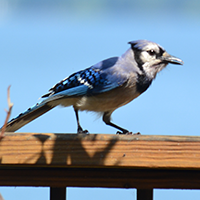
Photo: Zach Steinhauser
Habitat
Oak and pine woods, suburban gardens, groves, towns. Breeds in deciduous or mixed woods, avoiding purely coniferous forest. Maybe in fairly low or scrubby forest in southern part of range. Favors habitat with many oak or beech trees. Often common in well-wooded suburbs or city parks.
Feeding Behavior
Forages in trees and shrubs and on ground. Comes to feeders for seeds or suet. Pounds on hard nuts or seeds with the bill to break them open. Will harvest acorns and store them in holes in the ground.
For more information visit: https://www.audubon.org/field-guide/bird/blue-jay
Brown-headed Nuthatch
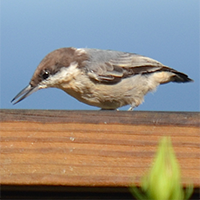
Photo: Zach Steinhauser
Habitat
Open pine woods. Pine species (such as loblolly, longleaf, slash, and pond pines) virtually always present in habitat; also other conifers including bald cypress and Atlantic white cedar. Often in pine woods mixed with deciduous trees such as sweetgum, oak, hickory, or sycamore.
Feeding Behavior
Forages mainly on the trunk and large limbs of pines, also on higher branches and twigs. Males may forage lower than females, descending on trunks almost to the ground. May use a chip of bark as a tool to pry off other pieces of bark while searching for insects. Sometimes catches flying insects in the air. May store seeds in bark crevices.
For more information visit: https://www.audubon.org/field-guide/bird/brown-headed-nuthatch
Blue-gray Gnatcatcher
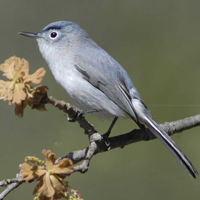
Gerard Bailey/VIREO
Habitat
Open woods, oaks, pines, thickets. Breeding habitat varies with region. In the east, mostly in deciduous forest dominated by oak, ash, or maple, or in southern pine woods with an understory of oak. In the west, often in more scrubby habitat, including pinyon-juniper woods, chaparral, streamside trees, oak forest. Winters in wooded or brushy areas, often near water.
Feeding Behavior
Forages actively in trees and shrubs. Searches for insects among leafy outer twigs of deciduous trees and on branches and trunk in pines. Takes most food while perched, also hovers to pick items from the surface, and often flies out to catch insects that it flushes from foliage. Large insects are beaten against a branch before being eaten.
For more information visit: https://www.audubon.org/field-guide/bird/blue-gray-gnatcatcher
Cardinal
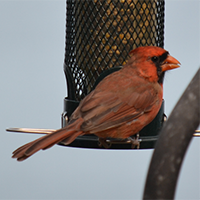
Photo: Zach Steinhauser
Habitat
Woodland edges, thickets, suburban gardens, towns, desert washes. Found in a wide variety of brushy or semi-open habitats in the East, from forest clearings and swamps to city parks, almost wherever there are some dense bushes for nesting. In the Southwest, more local; occurs in tall brush, streamside thickets, groves of mesquites in the desert.
Feeding Behavior
Forages mostly while hopping on ground or in low bushes, sometimes higher in trees. Readily comes to bird feeders, where it favors sunflower seeds.
For more information visit: https://www.audubon.org/field-guide/bird/northern-cardinal
Carolina Chickadee
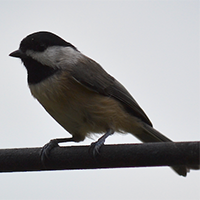
Photo: Zach Steinhauser
Habitat
Mixed and deciduous woods, river groves, shade trees. Mostly in deciduous forest, also in pine woods with a good mixture of oak or other leafy trees, and will nest in well-wooded suburbs. Habitat like that of Black-capped Chickadee; where the two species overlap in the Appalachians, Carolina Chickadee lives at lower elevations.
Feeding Behavior
Forages mostly by hopping among twigs and branches and gleaning food from the surface, often hanging upside down to reach the underside of branches. Sometimes takes food while hovering, and may fly out to catch insects in mid-air. Stores food items, retrieving them later. Comes to bird feeders for seeds or suet.
For more information visit: https://www.audubon.org/field-guide/bird/carolina-chickadee
Carolina Wren
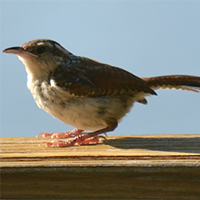
Photo: Zach Steinhauser
Habitat
Tangles, undergrowth, suburbs, gardens, towns. Common in the undergrowth of deciduous or mixed woods, and in thickets along forest edges. Also lives in suburban areas, especially where some dense low growth and tangles have been left undisturbed.
Feeding Behavior
Forages in pairs, actively exploring low tangles, foliage, bark of trunks and branches, and the ground. Sometimes comes to bird feeders for suet, peanuts, other items.
For more information visit: https://www.audubon.org/field-guide/bird/carolina-wren
Downy Woodpecker
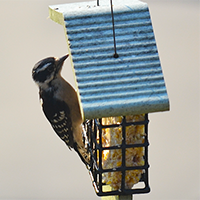
Photo: Zach Steinhauser
Habitat
Forests, woodlots, willows, river groves, orchards, shade trees. Found in a wide variety of habitats, from wilderness areas to second-growth woods to suburban yards, but generally, favors deciduous trees. In far north and mountains (areas dominated by conifers), restricted to groves of deciduous trees such as aspens or willows.
Feeding Behavior
Can forage not only on trunks and major limbs of trees but also on minor branches and twigs (often climbing about acrobatically and hanging upside down), as well as on shrubs and weed stalks. Male and female forage differently at times, but this varies with place and season. Feeding on trees, does more tapping and excavating in winter, more gleaning from the surface in summer.
For more information visit: https://www.audubon.org/field-guide/bird/downy-woodpecker
Eastern Bluebird
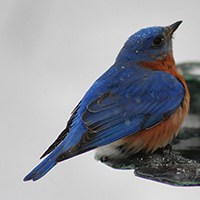
Photo: Zach Steinhauser
Habitat
Open country with scattered trees; farms, roadsides. Breeds in many kinds of semi-open habitats, including cut-over or burned areas, forest clearings, farm country, open pine woods; locally in suburbs where there are extensive lawns and good nest sites. Wanders to other habitats in winter.
Feeding Behavior
Does much foraging by perching low and fluttering down to ground to catch insects, often hovering to pick up items rather than landing. Also catches some insects in mid-air, and may take some while hovering among the foliage. Feeds on berries by perching or making short hovering flights in trees.
For more information visit: https://www.audubon.org/field-guide/bird/eastern-bluebird
House Finch
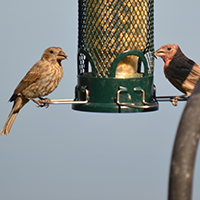
Photo: Zach Steinhauser
Habitat
Cities, suburbs, farms, canyons. Original habitat was probably streamside trees and brush in dry country, woodland edges, chaparral, other semi-open areas. Now most commonly associated with humans in cities, towns, and farmland, especially in areas with lawns, weedy areas, trees, buildings. Avoids unbroken forest or grassland.
Feeding Behavior
Forages on ground, while perching in weeds, or up in trees and shrubs. Except when nesting, usually forages in flocks. Will come to feeders for seeds, especially sunflower seeds, and to hummingbird feeders for sugar water.
For more information visit: https://www.audubon.org/field-guide/bird/house-finch
Mourning Dove
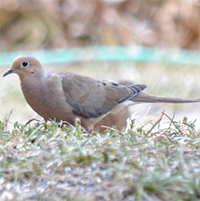
Photo: Zach Steinhauser
Habitat
Farms, towns, open woods, roadsides, grasslands. Found in almost any open or semi-open habitat in temperate parts of North America, including forest clearings, farmland, suburbs, prairies, deserts. May be most common in edge habitats having both trees and open ground, but also found in some treeless areas. Avoids unbroken forest.
Feeding Behavior
Forages mostly on the ground; sometimes will perch on plants to take seeds. Will come to bird feeders, often eating on the ground under elevated feeders. Eats quickly to fill crop with seeds, then digests them while resting. Regularly swallows grit (small gravel) to aid in the digestion of hard seeds.
For more information visit: https://www.audubon.org/field-guide/bird/mourning-dove
Pileated Woodpecker
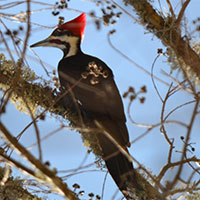
Photo: Zach Steinhauser
Habitat
Conifer, mixed, and hardwood forests; woodlots. Favors mature deciduous or mixed deciduous-coniferous forest, also coniferous forest. A wide variety of specific forest types from southern swamps to the old-growth Douglas-fir forest of the northwest. Also in second-growth and fragmented woodlots, as long as some large trees are present.
Feeding Behavior
Forages mainly by probing, prying, and excavating in dead wood in search of insects. May gouge deep holes in rotten wood to get at ant nests, sometimes tearing apart stumps and big sections of fallen logs. May clamber about acrobatically in small branches to get at berries.
For more information visit: https://www.audubon.org/field-guide/bird/pileated-woodpecker
Red-bellied Woodpecker
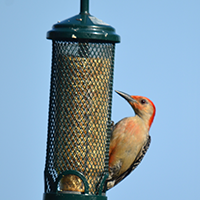
Photo: Zach Steinhauser
Habitat
Woodlands, groves, orchards, towns. Most common in deciduous forest, especially along rivers and in swamps. Also in mixed coniferous and deciduous forest, less often in pure stands of pine. May be found in rather open areas, such as forest edges and clearings, groves of trees in farm country, shade trees in suburbs.
Feeding Behavior
Forages by searching for insects on tree trunks and major limbs. Climbs and perches among branches to pick berries and nuts, and sometimes catches flying insects in the air. Nuts and seeds taken in fall may be stored in bark crevices, eaten during winter.
For more information visit: https://www.audubon.org/field-guide/bird/red-bellied-woodpecker
Ruby-throated Hummingbird
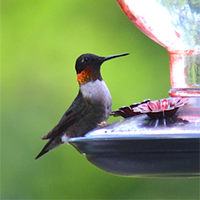
Photo: Zach Steinhauser
Habitat
Gardens, wood edges. Summers in a variety of semi-open habitats, including open woods, clearings, and edges in forest, gardens, city parks. Winters mostly in rather open or dry tropical scrub, not usually in the rain forest. Migrants may pause in any open habitat with flowers.
Feeding Behavior
At flowers, usually feeds while hovering, extending its bill and long tongue deep into the center of the flower. At feeders, may either hover or perch. To catch small insects, may fly out and take them in midair, or hover to pluck them from foliage. Sometimes takes spiders (or trapped insects) from spider webs.
For more information visit: https://www.audubon.org/field-guide/bird/ruby-throated-hummingbird
Tufted Titmouse
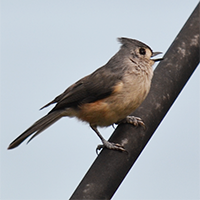
Photo: Zach Steinhauser
Habitat
Woodlands, shade trees, groves. Mostly in the deciduous forest with tall trees, sometimes in mixed forest. Can live in orchards, suburbs, or even city parks if trees are large enough.
Feeding Behavior
Forages by hopping actively among branches and twigs of trees, often hanging upside down, sometimes hovering momentarily. Often drops to the ground for food as well. Comes to bird feeders for seeds or suet. Opens acorns and seeds by holding them with feet and pounding with the bill. Will store food items, retrieving them later.
For more information visit: https://www.audubon.org/field-guide/bird/tufted-titmouse
White-breasted Nuthatch
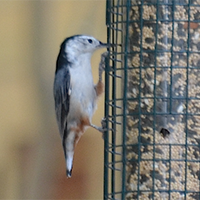
Photo: Zach Steinhauser
Habitat
Forests, woodlots, groves, shade trees. Typically in a mature deciduous forest, also in mixed forest with some conifers; rarely found in a pure coniferous forest. Often favors woodland edge, along rivers, roads, clearings; may be in suburbs or parks as long as large trees are present.
Feeding Behavior
Forages mainly on the trunk and larger limbs of trees, climbing about and exploring all surfaces. Sometimes feeds on the ground. During fall and winter, regularly catches food items in bark crevices on territory.
For more information visit: https://www.audubon.org/field-guide/bird/white-breasted-nuthatch

